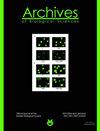风叶对高金属胁迫的恢复力:矿山和浮选尾矿库植物的抗氧化反应
IF 0.8
4区 生物学
Q4 BIOLOGY
引用次数: 0
摘要
蒲叶(香蒲)在人工浮选和矿山尾矿库的过渡地带形成天然林分,受到极高浓度的金属污染。我们评估了植物的吸收能力、金属向叶片的转移以及金属浓度升高对抗氧化酶活性的影响。测定了土壤酸度、基质中金属赝全含量和有效金属含量以及植物中金属浓度。研究了金属浓度升高对植物抗氧化酶(超氧化物歧化酶、过氧化氢酶、抗坏血酸过氧化物酶、愈创木酚过氧化物酶、谷胱甘肽还原酶)活性的影响。香蒲根中金属积累量高,向叶片转移速率低。金属浓度对抗氧化酶活性的影响取决于酶的类型、植物中金属浓度及其摩尔比,以及底物的pH值。抗氧化酶的高活性表明活性氧(ROS)的产生增加,表明金属解毒机制不足以抑制其毒性。对金属浓度升高的显著抗性和金属植物稳定的高效率表明,香蒲可以作为生物处理系统的一个有价值的组成部分,用于从pH值范围从超酸性到中性的多金属和严重污染的基质中去除金属。本文章由计算机程序翻译,如有差异,请以英文原文为准。
Typha latifolia resilience to high metal stress: Antioxidant response in plants from mine and flotation tailing ponds
Typha latifolia (cattail) forms natural stands in the transition zone of artificial flotation and mine tailings ponds and is contaminated with extremely high concentrations of metals. We assessed the absorption capacity of the plant, metal transfer to leaves, and the effects of elevatedmetal concentrations on antioxidant enzyme activities. Soil acidity, the pseudo-total and available metal content of the substrate, and metal concentrations in plants were examined. The effects of elevated metal concentrations in plants on antioxidant enzyme activities (superoxide dismutase, catalase, ascorbate peroxidase, guaiacol peroxidase, glutathione reductase) were assessed. Cattails exhibited high metal accumulation levels in roots and a low transfer rate to the leaves. The effects of metal concentrations on antioxidant enzyme activities were found to depend on the type of enzyme, metal concentrations in the plant and their molar ratios, as well as on the pH of the substrate. High activities of antioxidant enzymes indicate increased generation of reactive oxygen species (ROS) and show that metal detoxification mechanisms are insufficient to restrain their toxicity. Pronounced resistance to elevated metal concentrations and high efficiency in metal phytostabilization show that cattail could be a valuable component of biological treatment systems for removing metals from multi-metal and heavily contaminated substrates in the pH range from ultra-acidic to neutral.
求助全文
通过发布文献求助,成功后即可免费获取论文全文。
去求助
来源期刊
CiteScore
1.40
自引率
0.00%
发文量
25
审稿时长
3-8 weeks
期刊介绍:
The Archives of Biological Sciences is a multidisciplinary journal that covers original research in a wide range of subjects in life science, including biology, ecology, human biology and biomedical research.
The Archives of Biological Sciences features articles in genetics, botany and zoology (including higher and lower terrestrial and aquatic plants and animals, prokaryote biology, algology, mycology, entomology, etc.); biological systematics; evolution; biochemistry, molecular and cell biology, including all aspects of normal cell functioning, from embryonic to differentiated tissues and in different pathological states; physiology, including chronobiology, thermal biology, cryobiology; radiobiology; neurobiology; immunology, including human immunology; human biology, including the biological basis of specific human pathologies and disease management.

 求助内容:
求助内容: 应助结果提醒方式:
应助结果提醒方式:


